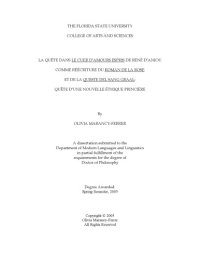
Ebook: La quête dans le Cuer d’amours espris de René d’Anjou comme réécriture du Roman de la Rose et de la Queste del Sang Graal: quête d’une nouvelle éthique princière
Author: Olivia Marancy-Ferrer
- Genre: Literature
- Year: 2005
- Publisher: The Florida State University College of Arts and Sciences
- Language: English
- pdf
In the Livre du Cuer d’Amours espris (1457), René d’Anjou declares that he was influenced by two major literary works from the Middle-Ages: the Romance of the Rose (1230-1270) and the Quest for the Holy Grail (1225-1230). The Livre du Cuer shares the qualities of profane love from the Romance of the Rose and the qualities of chivalry from the Quest. Our study provides a redefinition of a prince in France in the XVth century through the analysis of the transformation of two of the most important literary works of the Middle-Ages.
In the Livre du Cuer, King’s heart transforms into Cuer, a knight. This figure becomes the representation of the amalgam of both traditions. However, in the Livre du Cuer, René transforms numerous motifs from the tradition of medieval allegory. The transformation of the literary tradition and of the character Cuer, representatives of the amalgam of the traditions of the Rose and of the Queste, will be defined by us as “déshabillage littéraire” or “literary undressing.” While Cuer slowly abandons his attributes of knighthood and his “armor of love,” the text sheds its literary layers of medieval allegory found in the intertexts. The result of this transformation, or “déshabillage littéraire,” will be a redefinition of the ideal of a person’s worth. René d’Anjou uses the Romance of the Rose and the Quest for the Holy Grail to create a new « literary » and « princely » identity from the transformation of the texts and of their traditions. René goes beyond his role of a prince and suggests, through his text, new ideals of a person’s worth appropriate to the XVth century. The quest of the Livre du Cuer d’amours espris becomes a « mirror of princes » in which René’s identity as a complete man—a prince, a « reasonnable » lover, a spiritual man and a poet—will serve as an essemple for the man of his time and particularly for his friend and cousin Jean de Bourbon.
In the Livre du Cuer, King’s heart transforms into Cuer, a knight. This figure becomes the representation of the amalgam of both traditions. However, in the Livre du Cuer, René transforms numerous motifs from the tradition of medieval allegory. The transformation of the literary tradition and of the character Cuer, representatives of the amalgam of the traditions of the Rose and of the Queste, will be defined by us as “déshabillage littéraire” or “literary undressing.” While Cuer slowly abandons his attributes of knighthood and his “armor of love,” the text sheds its literary layers of medieval allegory found in the intertexts. The result of this transformation, or “déshabillage littéraire,” will be a redefinition of the ideal of a person’s worth. René d’Anjou uses the Romance of the Rose and the Quest for the Holy Grail to create a new « literary » and « princely » identity from the transformation of the texts and of their traditions. René goes beyond his role of a prince and suggests, through his text, new ideals of a person’s worth appropriate to the XVth century. The quest of the Livre du Cuer d’amours espris becomes a « mirror of princes » in which René’s identity as a complete man—a prince, a « reasonnable » lover, a spiritual man and a poet—will serve as an essemple for the man of his time and particularly for his friend and cousin Jean de Bourbon.
Download the book La quête dans le Cuer d’amours espris de René d’Anjou comme réécriture du Roman de la Rose et de la Queste del Sang Graal: quête d’une nouvelle éthique princière for free or read online
Continue reading on any device:

Last viewed books
Related books
{related-news}
Comments (0)